


Winter 2024 Newsletter
Happening in Hydro Hi folks, Hydropower is a tough field, and it can feel a little like an endless loop to work on similar issues across projects without seeing much change. That’s why is such a relief and a breath of fresh air to see FERC making policy changes...
Challenging the Hydropower Clean Energy Future Act: SYRCL’s Perspective
The South Yuba River Citizens League (SYRCL) believes it is crucial to address environmental issues with transparency and a commitment to facts. That is why we question some of the assertions made by hydropower providers as to the environmental benefits of their...
G-Res Tool Tutorial
This three-part G-res tutorial video series will help you gain a basic understanding of the G-res Tool and how to find information needed to model the net carbon footprints of your local reservoirs. Developed by the International Hydropower Association and the UNESCO...
BREAKING: Recent Report Shows hydropower Reservoirs in Alabama Emit *Substantial* Amounts of Methane
The Alabama Rivers Alliance (ARA), in partnership with PhD students from the Virginia Scientist-Community Interface (V-SCI), has used the G-res modeling tool to analyze the net methane and carbon dioxide emissions of two of Alabama Power’s hydropower facilities, and the results show that these supposedly “clean” and emissions-free hydropower dams and reservoirs actually create and emit significant quantities of methane, a potent greenhouse gas.
